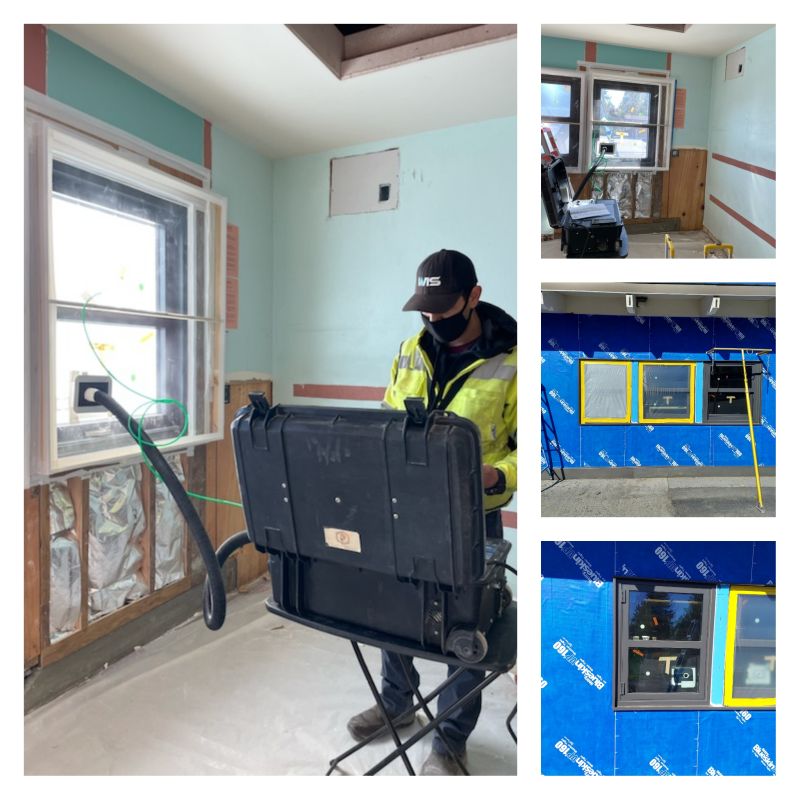ASTM E 783: Standard Test Method for Field Measurement of Air Leakage Through Installed Exterior Windows and Doors
LOS ANGELES | SAN FRANCISCO | SAN DIEGO
ASTM E783 | WIS Test Crew Performing a Field Air Leakage Test on a Window System
What is the ASTM E783 Test Method?
The full description of the test method is defined as the “Standard Test Method for Field Measurement of Air Leakage Through Installed Exterior Windows and Doors”. It is used on all types of fenestration products including: windows, doors, window walls, curtain walls, storefronts, skylights and exterior wall systems. In short, it is a test method for measuring air loss (also known as air infiltration) into a window, door, or wall product.
The test method is primarily specified on residential and commercial buildings as a quality control measure to check the airtightness of a window, door, or wall system to make sure that there is not any excessive air leakage occurring into the interior of the building. Having the correct amount of air leakage is essential for optimal energy performance in addition to preventing severe dust build-up and/or various insects from intruding into the home or building.
Note that this test method is also called out for in the AAMA 502 and AAMA 503 Voluntary Specifications for Field Testing.
Do you want to learn more about how we perform the ASTM E783?
ASTM E 783 | AIR LEAKAGE SCIENCE CLASS 101
“An Introduction to the Measurement of Air Leakage ”
Standard Test Method for Field Measurement of Air Leakage Through Installed Exterior Windows and Doors
- STEP 1: An interior test chamber is placed over the test specimen and sealed. Air from the test chamber is then vacuumed (exhausted) out at a specified pressure difference while simultaneously recording the amount of air leakage from the chamber. The pressure difference utilized is dependent on the rating of the product and the specific project. This sequence is performed in two (2) stages to record gross air leakage and also the test chamber tare air leakage.
- STEP 2: Chamber Tare Air Leakage. A plastic sheet is sealed over the exterior face of test specimen. Air is then vacuumed from the interior test chamber at the specified negative air pressure difference for the project or per the product’s rating. Air leakage is measured and recorded in Cubic Feet per Minute (CFM). This measurement is achieved by utilizing an air flow metering device.
- STEP 3: Gross Air Leakage. The aforementioned plastic sheet in step-2 is then removed and the measuring and recording process is repeated. By removing the exterior plastic sheet air loss is typically introduced into the test chamber requiring adjustments to get back to the specified negative air pressure difference. The increased air flow is then recorded.
- STEP 4: The Chamber Tare Air Leakage is deducted from the Gross Air Leakage which then provides the Net Air Leakage of the Test Specimen.
- STEP 5: Now that we know what the net air flow leakage is we can calculate the air infiltration rate of our test specimen. This is done by taking net air flow and dividing it by the ft² of test specimen. That provides an air flow rate in CFM/ft². We then compare the measured air infiltration flow rate with the maximum allowable air infiltration rate (cfm/ft² ) of the project specifications and/or product rating.
- STEP 6: If the measured air infiltration rate is lower than the maximum allowable air infiltration rate then the system achieves as PASS. If the the measured air infiltration rate is higher than the maximum air infiltration rate then the system archives a FAILURE.
- Note 6.1 – When a failure occurs it is typically investigated by the installer and/or product manufacturer and then remediated.
- Note 6.2 – After remediation is complete the product can then be retested.
Contact Us Now!
We provide our field testing services throughout all of California, Arizona, and Nevada. Some of the major metropolitan service regions we are currently in include but are not limited to: Los Angeles, San Francisco, San Diego, San Jose, Sacramento, Phoenix, and Las Vegas.
CALIFORNIA, ARIZONA & NEVADA
Phone: 888-381-7377

